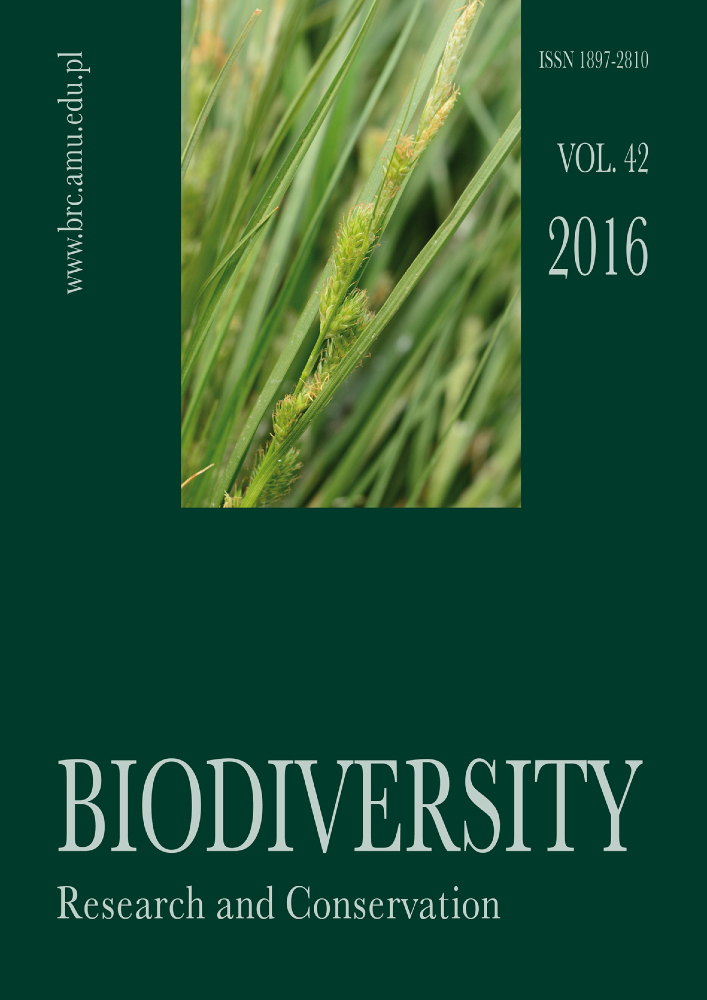Abstract
A new locality of rye sedge Carex secalina, a critically endangered species was discovered on an island of Lake Kusowo, in the vicinity of Bydgoszcz (Kuyavian-Pomeranian Province), in June 2015. The species was found in a breeding colony of black-headed gull Chroicocephalus ridibundus. The population size was estimated at least at 30 individuals and all of them produced generative shoots. This locality of C. secalina is the northernmost in Poland and the only ascertained, apart from Inowrocław Plain. Colonization of the island by C. secalina was caused, probably, by zoochory as a result of accidental bringing of propagules by gulls, together with nesting material from outside the colony.
References
Bogdanowicz A. M., Chmiel J., Lembicz M. & Żukowski W. 2014. CR Carex secalina Willd. ex Wahlenb. Turzyca żytowata. In: R. Kaźmierczakowa, K. Zarzycki & Z. Mirek (eds.). Polska Czerwona Księga Roślin. Paprotniki i rośliny kwiatowe, wyd. 3, pp. 709-711. PAN, Instytut Ochrony Przyrody, Kraków.
Bukaciński D., Rutkowska A. & Bukacińska M. 1994. The effect of nesting black-headed gulls (Larus ridibundus L.) on the soil and vegetation of Vistula River island, Poland. Ann Bot Fenn 31: 233-243.
Breslina I. P. 1987. Vegetation and waterbirds of Kolska Subarctic sea-island. 199 pp. Nauka, Leningrad.
Dominiak M. & Jakubas E. 2015. A new locality of weeping alkaligrass Carex secalina (Cyperaceae) in Poland. Steciana 19(1): 33-37.
Egorova T. V. 1999. The sedges (Carex L.) of Russia and adjacent States (within the limits of the former USSR). 772 pp. St. Petersburg State Chemical-Pharmaceutical Academy, St. Petersburg; St. Louis Missouri Botanical Garden Press, St. Louis.
Gillham M. E. 1956. Ecology of the Pembrokeshire Islands. V. Manuring by the colonial sea-birds and mammals, with a note on seed distribution by gulls. J. Ecol. 44: 429-454.
Gillham M. E. 1961. Alteration of breeding habitat by sea-birds and seals in western Australia. J. Ecol. 49: 289-300.
Hogg E. H. & Morton J. K. 1983. The effects of nesting gulls on the vegetation and soil of islands in the Great Lakes. Can. J. Ecol. 61: 3240-3254.
Hogg E. H., Morton J. K. & Venn J. M. 1989. Biogeography of island floras in the Great Lakes I: Species richness and composition in relation to gull nesting activities. Can. J. Bot. 67: 961-969.
Indykiewicz P. 2001. Mewy i rybitwy. Ekologia kolonii lęgowej śmieszki Larus ridibundus i rybitwy rzecznej Sterna hirundo w Myślęcinku. Leśny Park Kultury i Wypoczynku w Bydgoszczy.
Lembicz M., Bogdanowicz A. M., Chmiel J. & Żukowski W. 2009. Carex secalina (Cyperaceae), a critically endangered species of Europe: historic and new localities in Poland. Acta Soc. Bot. Pol. 78(4):311-320.
Mauersberger G. 1977. Über die Nestbauweise der einheimischen Möwenarten. Orn. Iber. Mus. Heineanum 2: 47-95.
Meusel H., Jäger E. & Weinert E. 1965. Vergleichende Chorologie der zentraleuropäischen Flora. I. Text 583 pp., Karten 258 pp. Gustav Fischer Verlag, Jena.
Piękoś-Mirkowa H. & Mirek Z. 2006. Flora Polski. Rośliny chronione. 584 pp. MULTICO Oficyna Wydawnicza.
Rutkowski L. 2004. Klucz do oznaczania roślin naczyniowych Polski niżowej. Wyd. II, popr. i unowocześnione, 814 pp. Wyd. Nauk. PWN, Warszawa.
Sobey D. G. & Kenworthy J. B. 1979. The relationship between Herring Gull and the vegetation of their breeding colonies. J. Ecol. 67: 469-496.
Zając A. & Zając M. (eds.). 2001. Distribution Atlas of Vascular Plants in Poland. xii+714 pp. Edited by Laboratory of Computer Chorology, Institute of Botany, Jagiellonian University, Cracow.




